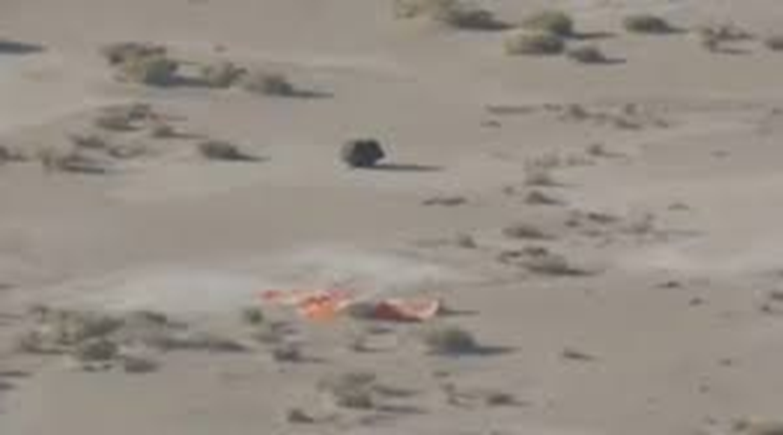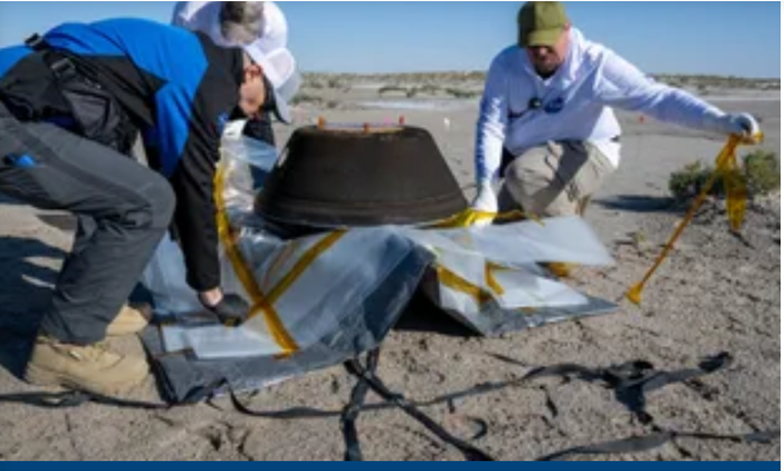NASA confirms the arrival of asteroid Bennu samples to Earth

What is the importance of Bennu asteroid samples arriving to Earth... in 83 seconds?
The US space agency NASA announced the arrival of samples of what it described as “the most dangerous rock known in the solar system” to Earth.
The capsule carrying the samples landed in the western desert of the US state of Utah, the culmination of a seven-year mission to study the rock.
Samples were collected from the surface of the asteroid Bennu in 2020 by the Osiris-Rex spacecraft.
NASA wants to know more about the mountainous object, for reasons including fears that it will strike our planet within the next 300 years.
Scientists expect the chemistry of the samples to reveal new information about the formation of planets 4.5 billion years ago, and perhaps even give insight into how life began on our world.

What will beno samples like?
NASA confirmed landing on DoD desert terrain at 10:52 local time (14:52 GMT). The tire-sized container initially moved at more than 12 km/s (27,000 mph) and experienced peak heating of more than 3,000 degrees. Celsius, but the heat shield and parachutes slowed his descent and dropped him gently on safe ground in the desert plain.
Long trip
The OSIRIS-REx spacecraft left Earth in 2016 to conduct research on Bennu, which could hit our planet late next century with very little probability.
It took the probe two years to reach the 500-meter-wide rock and another two years to observe the "Space Mountain" before performing a daring series of maneuvers that found a cache of surface material.
Scientists are looking forward to getting their hands on the precious cargo, estimated at about 250 grams (9 ounces).
This size may not seem like much, as it is equivalent to the weight of an adult hamster, as one scientist described it. But for the types of tests NASA teams want to perform, it's more than enough.
“Some of our instruments examine the atoms that make up the crystals inside these rocks,” said Dante Lauretta, principal investigator for Osiris-Rex.
The University of Arizona professor told BBC News: "When you work on this scale, a single stone represents an endless space to explore. We will be working with these materials for decades and decades into the future."
When recovery teams found the capsule on Earth, their motive was to return it to a temporary clean room at nearby Dugway Army Base as quickly as possible.

If, as the researchers believe, the sample contains carbon compounds that may have been involved in the creation of life, mixing the rocky material with current Earth chemistry should be avoided.
“The cleanliness of the spacecraft and preventing contamination was a strict mission requirement,” said Mike Morrow, deputy director of the Osiris-Rex project.
He added: "The best way we can protect the sample is to move it from the field to the clean laboratory that we have set up here in the hangar as quickly as possible, and subject it to a disinfection process with pure nitrogen gas. Then it will be safe."
Recovery teams will dismantle the capsule, remove its heat shield and back cover, leaving the sample safe inside an inner case.
Advance fears and preparations

Nobody wants a repeat of the Genesis accident
Scientists had concerns about a repeat of what happened with the Genesis capsule, which returned samples of solar wind in 2004.
The capsule's parachute had failed to open and it fell to Earth at more than 300 km/h (190 mph), opening its contents.
Richard Witherspoon of Lockheed Martin, the capsule's manufacturer, said: "We understand what went wrong at Genesis where some of the gravity switches were installed backwards."
He added, "There were a lot of double checks on the gravity switches in this capsule to make sure they were installed the correct side up, so we don't actually have any concerns about them getting in and turning on properly."

It was a rainy season in the western desert of Utah
Today the "hack team" was on standby in case the worst happened.
Meteorologists at the Utah Test and Training Group have been placing weather balloons in recent days to obtain the latest information to help predict the final landing position. The capsule spent five minutes dangling on its main chute. But with light winds forecast, it is unlikely to blow off course.
The biggest issue was the rain that the desert witnessed this year. There are stagnant pools and a little mud.
“This makes recovery difficult,” said Dan Roth, chief meteorologist at US Army Base Dugway.
“Vehicles may get stuck, but the upside is that the dust will be kept down, which is good for the equipment,” he added.

Helicopters were flying near the expected landing site of the capsule
A sample for posterity
Monday is scheduled to witness the transport of this canister by air to the Johnson Space Center in the US state of Texas, to begin analyzing the samples.
British scientist Ashley King will be part of the six-person "quick look" team, which will carry out the initial assessment.
"I expect to see very soft and fragile rocky material," the Natural History Museum expert said.
He added: "It will contain clay minerals, silicate minerals that have water trapped in their structure. And a lot of carbon, so I think we will probably see carbonate minerals, and perhaps some things we call chondrules and also impurities of calcium and aluminum, which were the first solids to form in our system." "Solar".
NASA plans to hold a press conference on October 11 to announce the results of its initial examination. Small samples will be distributed to associated research teams around the world, with the hope of reporting on a range of studies within two years.
Lori Glaze, NASA's planetary science director, told BBC News: "One of the most important parts of the sample return mission is that we are taking 75 percent of that sample and we will preserve it for future generations, for those who have not yet been born to work in laboratories that are not yet established, using instruments." We haven't thought about it yet."
After the capsule is dropped, NASA's flyby probe will be directed to another asteroid called Apophis, expected in 2029.
Source: websites

